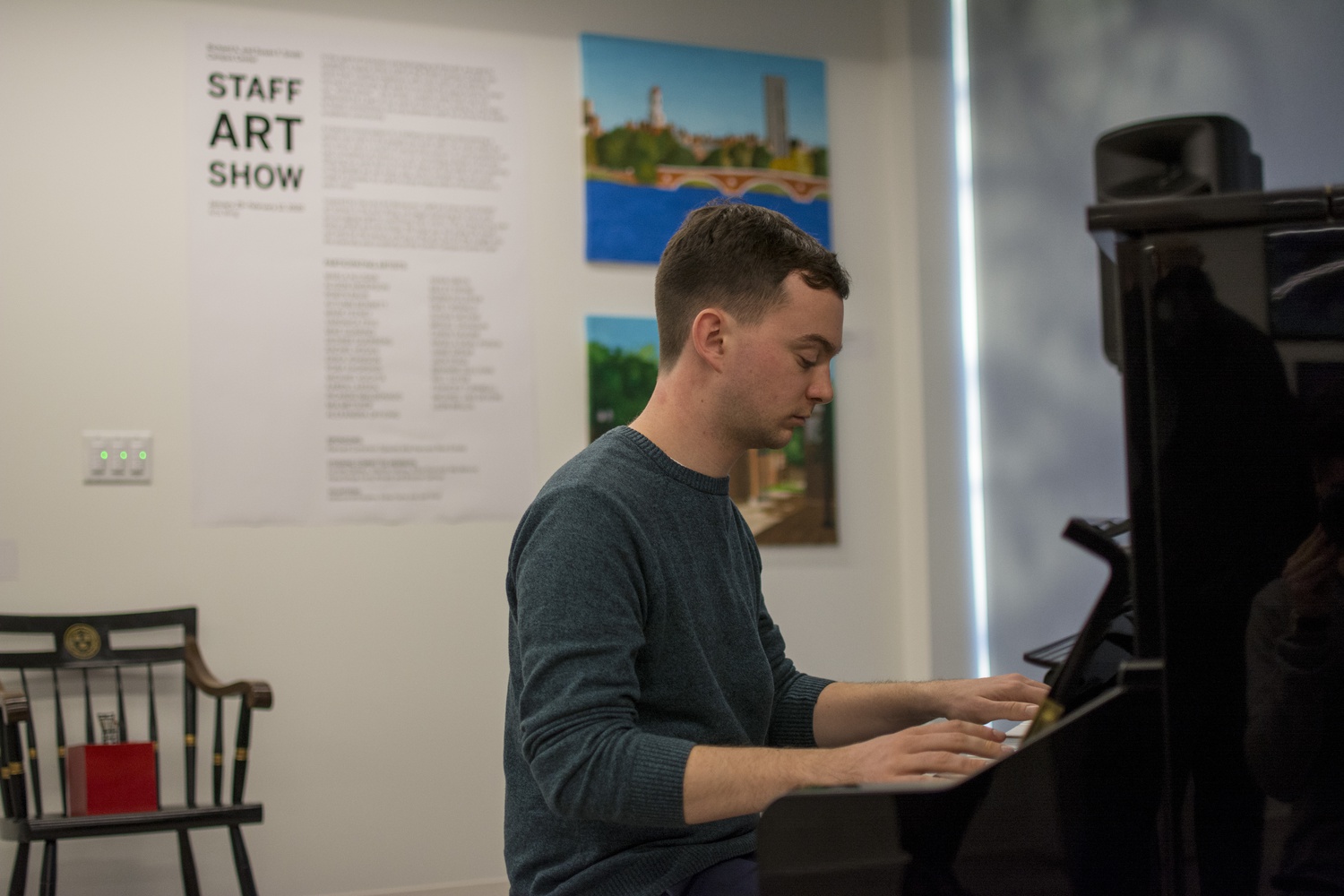
Harvard’s Hidden Staff Artists
I follow the flyers to the Arts Wing on the second floor of the Smith Campus Center, a low-ceilinged, seldom-trafficked space. I’m looking for the opening reception for the first-ever Smith Campus Center Staff Arts Show, an exhibition featuring over 50 pieces of artwork by more than 30 Harvard staff members.
The space, rectangular and painted white, is itself a blank canvas, primed for the colors and textures of artwork on its walls: a quilted self-portrait, a watercolor diver leaping off a springboard, a photograph of the sun-dappled space beneath the Harvard Stadium bleachers, geometry-inspired wooden furniture. Artists and art enthusiasts alike mill about, chatting, laughing, and occasionally dipping into the catered spread on a folding table in the back.
The show’s goals are threefold: to showcase the staff’s artistic talent, to foster inclusion and belonging, and to build community. The vision statement reads: “We want to provide the opportunity to show our ‘whole selves’ — the artistic, creative sides that may not otherwise be a part of our work at Harvard.” For many participants, their artistic pursuits long predate their campus jobs.
Karen M. Larsen, a staff assistant at the Graduate School of Arts and Sciences, used to work full-time selling quilts at high-end craft fairs, a passion she inherited from her mother. At the show, she displays one such quilt, a portrait of her younger self surrounded by waves of color and punctuated by delicate embroidery. Her inspirations are varied: Van Gogh’s brushstrokes, abstract use of fabric and color, and what she described as an “Amish” aesthetic.
Jack P. Staid, an administrator at Harvard University Health Services, has been taking piano lessons since age six and pursuing composition since high school. He performs three original piano compositions throughout the show, each filled with rich and vibrant chords.

Both Larsen and Staid see their jobs on campus as complementary, and even beneficial, to their artistic pursuits. For Larsen, the switch to a nine-to-five has provided the stability and financial security to pursue art in her free time, and Staid enjoys using Harvard’s practice rooms. Both mention the opportunity to take Extension School classes as a major perk of the job, with Larsen taking a photography course and Staid planning to enroll in an urban design course.
“We want a way to show [that] the ‘work self’ is not the only one that defines us,” says Emily Ronald, a committee member and participating artist, who echoes the show’s commitment to create a space for peoples’ “whole selves.” Or, as fellow organizer Camille R. Gladieux explains more bluntly, “we want to be celebrated beyond our capitalistic production.”
The celebration is also intended to extend beyond just the staff community. Art show participant Brianne Sullivan, a Harvard administrative assistant, says the show is partly inspired by a longer-established art show for staff of the Harvard Art Museums. But whereas the museum staff show is held in the Harvard Art Museums basement and open to Harvard ID access only — “people couldn’t even bring their spouses,” Sullivan explains — the Smith Center show seeks to create dialogue between all parties on campus, by virtue of its more central location and its status as free and open to the public.
Leon C. Welch, an HUHS employee of 33 years and an avid knitter, hopes the show will foster more meaningful interaction between staff, students, and faculty. He says there is, at times, a general sense that Harvard students are “privileged” and “spoiled,” but he is a firm believer in the uniting power of art. He hopes faculty and students will see a new side of the staff through the show and will be able to recognize the “things that come from their heart, that they do without pay.” Welch proudly shows me two cabled hats: one black and one lavender with a pom-pom on top. The lavender, he explains, is for a worker at Saloniki Greek and the black one for a worker at Tatte Bakery.

The opening reception is lively, but aside from two student photographers covering the event, I seem to be the only student in attendance. Most of the attendees appear to be fellow staff members, admiring their colleagues’ work. If there are faculty members present, they are not immediately visible to me. Of all the visions for the show, “establishing a space where the staff can share their creative endeavors with each other” seems to be the most successful.
Nonetheless, the sense of community is strong, and even though I’m not a staff member, I feel welcomed. Larsen shakes my hand and thanks me sincerely. Welch tells me I’ve changed his opinion on Harvard students and wishes me the best of luck.
On my way out, I pass a wall-sized sheet of paper open to artwork from anyone. So far, this “Collaborative Art Wall” is mostly blank, but a few drawings jump out: a llama with glasses, a colorful gnome, and a wonderfully nonsensical poem. To the left, beside a box of markers, a sign: “Art is for everyone.”
— Magazine writer Maliya V. Ellis can be reached at maliya.ellis@thecrimson.com


